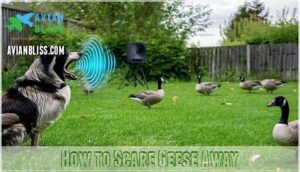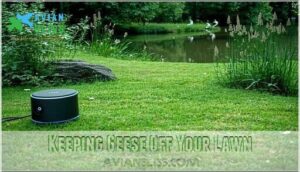This site is supported by our readers. We may earn a commission, at no cost to you, if you purchase through links.

Loud, sudden noises like air horns or banging pots can startle them, sending them flying. Propane cannons, often used on farms, create controlled blasts that say, “Not today, geese!”
Ultrasonic devices claim to work, but studies suggest they’re hit-or-miss since geese may not hear those frequencies well. Even shouting works short-term—just hope the neighbors don’t think you’ve lost it.
Geese are smart, though, and can adapt, so mixing sounds and timing keeps them guessing. Want more strategies? It’s all about variety and timing!
Table Of Contents
- Key Takeaways
- Noises That Scare Geese
- Types of Goose Deterrents
- How to Scare Geese Away
- Effective Goose Repellents
- Keeping Geese Off Your Lawn
- Protecting Your Property From Geese
- Getting Rid of Geese in Ponds
- Preventive Measures for Goose Control
- Canada Goose-Specific Solutions
- Long-Term Goose Control Strategies
- Frequently Asked Questions (FAQs)
- How do you scare off geese?
- Do air horns scare geese away?
- Does ultrasonic sound repel geese?
- How do you get rid of noisy geese?
- What are geese most afraid of?
- Will an air horn scare geese?
- How to scare geese away?
- What noise will scare away geese?
- What sounds can scare geese away?
- Can a noisemaker scare geese away?
- Conclusion
Key Takeaways
- Use loud, unpredictable noises like air horns, propane cannons, or banging pots to startle geese and make them leave.
- Predator sounds, such as hawk screams or coyote howls, mimic threats and scare geese effectively.
- Mix up your deterrents and change their timing to keep geese from adapting to predictable patterns.
- Pair sound deterrents with visual barriers like reflective tape or physical barriers for a stronger impact.
Noises That Scare Geese
Geese hate loud, unexpected sounds because they signal danger and disrupt their calm. Predator calls, distress signals, or even dog barks can quickly send them packing.
Loud, unpredictable noises are like red flags for geese—they scream danger and send them scrambling for safer ground.
Goose-Repelling Sounds
Sound waves can be your secret weapon for handling pesky geese. These birds have sharp hearing and instinctively react to noises resembling danger. Choosing the right geese repellent noises guarantees your yard stays goose-free without drama.
Here are effective goose deterrent sounds:
- Predator bird sounds – Hawk screams and coyote howls are exceptional audio deterrents that mimic real threats.
- Distress calls – Goose calls screaming “Disaster ahead!” frighten them into leaving.
- Randomized sonic devices – Devices creating unpredictable scaring geese sounds keep them guessing and unsettled.
Remember, it’s about tricking geese into thinking the area is unsafe. With these goose deterrent sounds in play, you’ll turn your space into a sonic goose repellent zone! Using sound deterrent methods can help you effectively keep geese away from your lawn.
Ultrasonic Devices
Tired of noisy geese taking over your lawn? Ultrasonic devices might be your secret weapon. These gadgets emit ultrasonic sounds—high-frequency tones between 16-45 kHz—that geese find unbearable but humans can’t even hear. They’re the perfect sonic goose repellent, especially for ultrasonic bird control in areas up to an acre.
For device effectiveness, place them near water sources or common landing spots.
Pair them with other tools, like visual deterrents, to keep those pesky geese on their toes! Frequency settings let you tweak the intensity to match goose activity.
Plus, many models are weather-resistant and solar-powered, so maintenance is a breeze. Think goose-proofing couldn’t be this clever? Think again! Effective goose control methods can also involve combining ultrasonic devices with other deterrents for the best results.
Pyrotechnics
Got geese invading your yard? Pyrotechnics might be your answer. These specialized noise-makers, like Bird Bangers, Shell Crackers, Whistle Rockets, and Firecrackers, scare geese with explosive sounds. They’re less backyard fireworks and more heavy-duty sonic repellents.
When using pyrotechnics, always prioritize safety and follow these tips:
- Check local rules on noise pollution before setting anything off.
- Keep supplies dry and away from heat.
- Light safely—maintain a safe distance before igniting.
- Stick to daylight to reduce disruptions.
- Be fire-ready by having water or an extinguisher nearby.
Used properly, tools like Report Makers or Whistle Rockets create noise geese won’t forget, convincing them to retreat fast.
Propane Cannons
Propane cannons are a powerhouse in the context of sound-based goose control. These devices release loud booms that geese perceive as danger signals.
To use them effectively, follow these tips:
- Strategic Placement: Install propane cannons near ponds, lawns, or other goose hotspots.
- Scare Tactics: Program random fires between 30 seconds and 30 minutes to keep geese guessing.
- Sonic Blasts: With noise levels reaching 120 dB, these sonic goose repellents mimic predator sounds to scare geese away.
To avoid goose complacency, mix timing and locations regularly. Though effective, be mindful of local noise rules to keep neighbors happy.
Propane cannons are your ace against those unwelcome visitors!
Electronic Repellents
Modern sound devices like the GooseBuster PRO are powerful tools for sound-based goose control.
These electronic deterrents broadcast a mix of goose distress calls, predator sounds, and even sharp noises like coyote barks or gunshots. Think of it as a sonic goose repellent playlist designed to keep geese uneasy.
Sonic repellents like these work best for open spaces and can cover up to 1.5 acres. They’re weather-resistant, reliable, and ideal for yards, parks, or large lawns.
By using sound waves strategically, this electronic goose repellent creates an environment that geese want nothing to do with. Say goodbye to noise makers like pots and pans—let technology take over! Effective Electronic Goose Control methods are essential for long-term results, providing a long-term solution with reliable and weather-resistant features.
Natural Sounds
Nature’s playlist can send geese packing. Using natural sounds plays on their survival instincts.
Try these effective methods:
- Play goose distress calls and predator bird sounds, like hawks or eagles, to mimic danger.
- Add coyote predator sounds for geese to create the illusion of lurking threats.
- Use water sounds or relaxing nature tones to unsettle their comfort.
These wildlife alerts keep geese guessing and wondering if it’s time to move!
Types of Goose Deterrents
Regarding keeping geese off your lawn, you’ve got several effective options. From sound-based devices to physical barriers, each method targets their instincts to flee potential danger.
Visual Deterrents
In the case of visual deterrents, geese aren’t fans of feeling watched or confused.
Hang shiny reflective tape that flashes in the sunlight or set up balloon deterrents with big “eyes” to unsettle them.
Moving scarecrows and swaying predator decoys, like owl figures, mimic threats they can’t ignore.
Even simple grid patterns can throw geese off.
Pair these with sound for a combo that really sends them packing!
Physical Barriers
Physical barriers are like setting up a "no-go zone" for geese. Combine these with goose repellent sounds or a sonic goose repellent for double protection.
Smart fence installation keeps your space secure and stylish using functional barrier systems.
- Netting materials over ponds block geese from landing.
- Landscape modification like tall shrubs or hedges adds natural barriers.
- Durable border fencing secures lawns while blending into the scenery.
- Layer barriers—think gates plus screens—for maximum effectiveness.
- Make certain fences are sturdy, weather-resistant, and deeply anchored.
When geese feel unwelcome and boxed out, they’ll quickly look for easier turf.
Habitat Modification
If geese treat your yard like their personal buffet, a bit of habitat modification can turn the tables.
Tweaking your landscape design makes your space less appealing to these uninvited guests:
- Grass height matters—let it grow to at least 6 inches.
- Taller grass reduces visibility, making geese uneasy.
- Use native plants for shoreline management, adding a 4-foot buffer of shrubs or wildflowers to the edges of ponds or water features.
- Plant aromatic herbs like lavender or rosemary near water features.
- Strong scents feel like the “keep out” signs of nature.
- Replace grassy zones with rock-and-mulch xeriscaping, which geese dislike for its lack of nesting appeal.
- These simple tweaks disrupt food and shelter, encouraging them to move on.
Auditory Deterrents
Tired of geese taking over your yard? Sound waves can send them packing! Using sonic repellents, like audio devices that mimic predator sounds to scare geese, triggers their instinct to flee.
Even better, sonic goose repellents can blast goose deterrent sounds like distress calls that scream “danger.” Place these acoustic deterrents near water or feeding areas for maximum effect, but keep the patterns unpredictable—geese get used to repetitive noise.
Here’s a quick guide:
Type Effectiveness Pro Tip
With these audio goose deterrents, your lawn becomes goose-free—no honking, no problem!
How to Scare Geese Away
If geese are taking over your yard, you can use sounds to keep them away. Predator calls, distress noises, or even barking dogs can scare geese effectively.
Using Sound Deterrents
Think of sound deterrents as the goose equivalent of a scary movie soundtrack.
Using audio repellents effectively requires planning:
- Place sonic devices at a goose’s height to spread sound waves efficiently.
- Mix predator sounds to scare geese with distress calls—they’ll think danger’s near.
- Opt for weatherproof acoustic deterrents that withstand rain and wind.
- Schedule goose deterrent sounds during busy grazing hours.
Check noise pollution laws before installing noisy gear.
Geese aren’t fans of surprises, so changing sound patterns keeps them guessing.
A well-timed sonic goose repellent can turn your lawn into a no-go zone for feathered invaders.
Combining Methods
When geese get too comfortable, it’s time to mix things up with hybrid methods.
Combine sound tactics, like predator sounds or distress calls, with visual decoys and habitat changes for a multi-sensory, layered defense.
Motion-activated sprinklers can add extra unpredictability, keeping geese on their toes—literally.
For example, pairing a sonic goose repellent with tall grass or reflective tape creates double the trouble for them.
This combo strategy confuses, startles, and removes their comfort zones, making your lawn the last place they’ll want to land.
Strategic Placement
Picture your yard as a strategic gameboard, with geese as unwelcome opponents. Winning depends on sound placement and smart positioning of your sonic repellents. These feathered visitors love calm grassy spaces and ponds, so set deterrents where geese prefer to hang out.
Turn your yard into a battlefield where geese lose every time—strategic sound placement wins the game!
Install noise deterrents in clusters near entry points or food sources, using overlapping zones to keep them guessing. Spread devices along property edges to create a “no-go” perimeter. Cover open areas they might land on with scattered ultrasonic sounds or predator sounds.
Think about direction and height—angling speakers toward ponds or nesting spots guarantees geese can’t escape the disruptive noise.
- Use motion-activated deterrents for random bursts of sound.
- Map areas geese frequent, creating targeted zones for noise control.
- Relocate devices periodically to keep geese unsettled and avoid sound habituation.
Varying Sounds and Intensity
Changing up the noise to scare geese works wonders—they’re clever, but they hate unpredictability.
Use predator sounds to scare geese, like hawk calls, paired with goose distress signals.
Shake things up with ultrasonic waves or loud sonic blasts to throw them off. Alter noise levels, timing, and audio frequencies randomly so the geese can’t adapt.
For example, predator growls work well near nesting sites, while high-pitched goose repelling frequencies suit quiet areas.
Accompany your sounds with flashing lights or moving decoys for a stronger impact. In the case of sounds that drive geese away, a little creativity keeps them guessing—and moving!
Effective Goose Repellents
You can use effective tools like the Goose D-Fense System or Critterfence to keep geese away.
These repellents create physical barriers or make your lawn less inviting without harming the birds.
Goose D-Fense System
If geese are making themselves too comfortable, the Goose D-Fense System is a game-changer.
This retractable fence sets up in under 10 minutes, effortlessly blocking access to food and water with nearly invisible nylon lines. It’s perfect during the summer molt when geese can’t fly.
Pair it with sound deterrents like predator sounds or goose distress calls for maximum impact.
- Quick installation: Takes just minutes to assemble.
- Unobstructive design: Keeps views clear while offering strong protection.
- Effective deterrent: Works well alongside electronic bird deterrents or sonic repellents.
Enjoy a conflict-free yard with this simple yet powerful solution.
The system’s effectiveness can be enhanced by understanding the defense product options available for different scenarios.
Critterfence
Why let pesky geese ruin your yard when Critterfence offers an elegant solution? This durable barrier system keeps wildlife out while blending seamlessly into your landscaping.
It’s perfect for yard protection and pairs well with sonic goose repellents and bird scaring sounds. Experts make fence installation simple, guaranteeing lasting security.
Critterfence works like a fortress, keeping geese at bay while compatible with predator sounds to scare geese. The effectiveness of Critterfence systems relies on proper fence material quality.
Garden Craft Black Metal Steel Border Fencing
A well-chosen garden fence can be your secret weapon against pesky geese.
Garden Craft Black Metal Steel Border Fencing combines durability with elegance, offering excellent yard protection and garden barriers that blend seamlessly into your space.
Here’s why it works:
- Strong metal fencing resists damage and guarantees lasting performance.
- A weather-resistant finish stands up to the elements year-round.
- 50-foot coverage secures large areas, protecting your garden effectively.
- Fence installation is quick and hassle-free.
Pair it with sonic goose repellents or predator sounds for unbeatable goose control.
Protective Pond Netting
Protective pond netting is your pond’s invisible shield, keeping geese from turning your tranquil retreat into their favorite hangout. This water barrier deters geese by blocking their landing and nesting areas while safeguarding your pond’s beauty.
Here are 3 reasons it works:
- Protects pond health: Goose droppings harm koi, plants, and water quality.
- Durable netting materials: Opt for UV-resistant mesh secured with sturdy anchors for long-term use.
- Easy fence installation: Position the net slightly above the surface to prevent sagging.
For maximum impact, pair netting with geese predator sounds or noise to scare geese off. It’s an easy, humane way to reclaim your yard! Using effective visual deterrents can also help keep geese away from your pond.
Spray Goose Repellent
A good repellent spray can stop geese from feasting on your lawn. Products with methyl anthranilate, a grape-flavored chemical deterrent, irritate geese’s trigeminal nerves, making grass unappetizing. Liquid barriers like Bobbex-G and Liquid Fence work well, especially when paired with other deterrent systems like predator sounds. Apply in dry conditions and reapply after rain—geese won’t stay long!Product Coverage Longevity Feature
Keeping Geese Off Your Lawn
Your lawn isn’t a goose hangout—take control with a few tweaks and clever strategies.
Geese love short grass, smooth waddling zones, and wide-open views, so change the rules of the game:
- Grow taller grass to make grazing unappealing.
- Plant shrubs or tall vegetation to block sightlines to water.
- Scatter rocks or uneven surfaces so geese can’t waddle comfortably.
Boost effectiveness with sonic goose repellents like predator calls, distress signals, or other loud goose repellent sounds.
Timing matters—rotate these sound deterrents often to prevent habituation.
Make your lawn hostile to them, not you!
Protecting Your Property From Geese
You can protect your property from geese by combining sound deterrents with physical barriers. Adding a barking dog or predator noises can make geese think twice about sticking around.
Fencing and Netting
Perimeter fencing and netting materials are your first line of defense against pesky geese.
Opt for barrier systems with sturdy mesh sizes that block entry but keep views clear—perfect for securing a goose-free zone.
A proper fence installation guarantees geese won’t cross into your yard, no matter how determined they are!
Pair yard fencing with predator sounds or noise deterrents for added punch.
Use netting systems to reinforce vulnerable spots, creating an impenetrable fortress geese can’t breach.
Effective visual deterrents, such as using geese control methods, can also be used to keep geese away from your property.
Motion-Activated Deterrents
While fences create physical barriers, motion-activated deterrents add an intelligent layer of protection that works even when you’re not watching.
The Bird B Gone Scarecrow connects to your garden hose and springs into action when geese waddle too close, blasting them with a surprising spray of water that sends them flying.
These smart devices use motion sensors to detect unwanted visitors and automatically trigger deterrents.
- Motion-activated sprinklers detect movement and shoot water jets that startle geese without harming them
- Solar-powered sound devices like the Bird Chase Super Sonic broadcast predator attacks and work even on cloudy days
- Ultrasonic burst devices emit high-frequency sounds that irritate geese but are inaudible to humans
- Activated lights with sudden flashes create discomfort zones geese quickly learn to avoid
These high-tech solutions turn your yard into a no-landing zone without requiring constant monitoring, utilizing smart devices and intelligent layer of protection to keep geese away.
Removing Food Sources
Your backyard buffet might be secretly inviting unwanted feathered guests!
Cut off the goose food supply by replacing Kentucky bluegrass with less appetizing fescue varieties. Maintain grass at 4-6 inches and skip spring fertilizer to reduce lawn appeal.
For effective food removal, secure trash containers, remove bird feeders, and eliminate standing water sources.
These simple lawn care techniques create a natural geese deterrent without requiring predator sounds or bird distress calls—making your property substantially less attractive to these hungry visitors.
Using Dogs to Scare Geese
After removing food sources, you might consider enlisting a four-legged ally in your goose control efforts.
Dogs are nature’s perfect goose deterrents. Are geese afraid of dogs? You bet! Their natural instinct recognizes dogs as predators, triggering their flight response.
When training your canine helper, focus on:
- Border Collies and similar herding breeds excel at this job
- Use consistent commands and positive reinforcement
- Train specific barking patterns that scare geese but won’t annoy neighbors
- Practice controlled chasing within property boundaries
- Always prioritize both dog safety and ethical treatment of geese
A well-trained dog provides an effective, humane solution to your goose problems.
Getting Rid of Geese in Ponds
Geese have transformed your serene pond into their personal bathroom and social club.
Reclaim your water feature with effective sound-based strategies that maintain ecological balance.
For ideal pond management, pair sounds that drive geese away with strategic landscaping.
Create a buffer of tall cattails or rushes—geese hate areas where predators might hide.
Effective visual deterrents can also be used to scare geese away.
Position weatherproof speakers to broadcast predator sounds to scare geese or goose distress noises at irregular intervals to prevent habituation.
Sound-based goose control works best when implemented before nesting season starts.
For stubborn fowl, floating alligator decoys add visual reinforcement to your audio deterrents.
Preventive Measures for Goose Control
You’ll save yourself countless hours of goose-chasing by setting up preventive measures before these honking invaders claim your lawn as their territory.
Combining sound deterrents with landscape modifications creates an unwelcoming environment that keeps geese flying right past your property without a second glance, utilizing sound deterrents to ensure they do not stop.
Regular Maintenance
While ponds can attract geese, keeping your sound deterrents in working order is just as important for protection.
Regular maintenance guarantees your noise deterrents remain effective against stubborn geese. Here’s what your monthly device checks should include:
- Run sound tests to verify predator sounds to scare geese are working properly
- Check and replace batteries before they fail (nothing worse than silent alarms!)
- Clear debris from speakers that might muffle goose distress calls
- Update sound frequency patterns to prevent habituation
- Schedule updates for your system’s timing and sensors
Your noise calibration efforts pay off when geese decide your yard isn’t worth the stress.
Timing and Frequency
Consistently maintaining your deterrent system demands smart timing and frequency adjustments for lasting success.
Like playing a game of hide-and-seek with geese, your sound patterns need strategic scheduling:
- Deploy random noises during dawn patrols (5-8 AM) when geese are most active
- Set interval scheduling for midday deterrence (11 AM-2 PM) with varied durations
- Implement refresh rates during evening feeding times (4-7 PM)
- Adjust frequency settings every 2-3 days to prevent habituation
Your timing strategies work best when unpredictable—geese quickly learn to ignore clockwork patterns. "I’ve found geese are like my teenagers," jokes wildlife expert Tom Miller. "They tune out predictable warnings but jump at unexpected sounds.
Duration control matters too—keep sounds brief but impactful for maximum effectiveness.
Canada Goose-Specific Solutions
You’ll need specific tactics to outsmart Canada geese since they’re sensitive to predator calls like hawk screams and coyote howls.
These stubborn lawn invaders also flee when they hear the distress calls of fellow geese, basically Mother Nature’s way of posting a "no trespassing" sign on your property.
Understanding Canada Goose Behavior
Now that we’ve covered prevention, let’s look at what really makes Canada geese tick—it’s like knowing your opponent’s playbook before the big game.
Canada geese aren’t just random lawn invaders; they’re smart birds with complex social behaviors that influence how they respond to deterrents.
- Their brain power includes remembering faces, sounds, and locations for years—that’s why they’ll return to your yard if they’ve found food there before
- They communicate through over 13 different honks and body language signals that alert the entire flock to danger or food sources
- During migration, they maintain strict flying formations that reflect their hierarchical flock dynamics on the ground
These birds follow predictable feeding patterns, typically grazing at dawn and dusk. They’re constantly on alert, even sleeping with one eye open!
Understanding these behaviors helps you create sound deterrents that actually work against their natural instincts.
Habitat Preferences
Now that you understand goose behavior, let’s look at where these feathered neighbors prefer to set up shop.
Canada geese aren’t random squatters—they’re strategic house hunters who seek specific terrain features:
They’re drawn to areas with minimal vegetation density, offering unobstructed views to spot potential predators while having water nearby.
That’s why golf courses become their favorite hangouts—these places offer the perfect combo of short grass for feeding with convenient nesting sites.
Understanding these habitat preferences helps when planning your goose deterrent strategy, especially when using goose predator sounds or distress calls to repel geese.
Feeding Habits
Canada geese eat like clockwork, grazing on your lawn at dawn and dusk with surprising precision.
Their feeding habits make them unwelcome guests around homes and parks.
- They prefer tender, short grass (under 6 inches) where predators are easily spotted
- They consume up to 3 pounds of grass daily, leaving behind 1-2 pounds of droppings
- Water access is essential – geese rarely feed far from escape routes to ponds
- During nesting season, they establish strict grazing patterns within 150 feet of their sites
Want them gone? Try goose repellent sounds like distress calls to repel geese. Sounds that drive geese away, especially geese predator sound effects, disrupt their comfortable feeding routine.
Understanding the role of nature’s cleanup crew can also provide insights into managing wildlife in urban areas. This approach helps in maintaining a balance between human presence and natural habitats, ensuring that both coexist peacefully, which is crucial for ecosystem health and biodiversity conservation.
Breeding Patterns
Geese’s family-focused breeding patterns make them predictable targets for sound deterrents.
From March to June, pairs return to familiar nesting sites near water, with females laying 4-7 eggs while males stand guard.
After 30 days, goslings hatch and form "crèches" – protective family groups that stick together.
This consistent behavior creates perfect timing for using predator sounds for geese or distress calls to repel geese, especially when they’re most protective during breeding seasons.
Long-Term Goose Control Strategies
You’ll need a mix of sound deterrents and physical barriers to keep geese away for good.
Research shows combining predator calls with landscape changes, like taller grass and fences, reduces goose populations by over 70% within weeks, which is a significant reduction achieved through landscape changes.
Creating a Hostile Environment
In the battle against unwanted geese, transforming your yard into hostile territory can send these feathered invaders packing. Sound waves are your secret weapon in this goose-deterring strategy.
- Deploy sonic repellent devices that broadcast predator noises or goose alarm calls at random intervals
- Install reflective objects that create unsettling light patterns across your lawn
- Modify goose habitats by planting tall grasses or thorny shrubs near water access points
- Set up motion-activated sprinklers that surprise geese with unexpected water jets
This noise pollution, combined with environmental changes, disrupts their comfort zone. When geese can’t relax, eat, or feel safe in your space, they’ll seek quieter pastures elsewhere—leaving your lawn goose-free.
Using a Variety of Methods
Building on your hostile environment strategy, the key to long-term success lies in mixing multiple deterrent methods. Geese are smart creatures that quickly adapt to single tactics.
Method What You’ll Need Set-Up Time Maintenance Effectiveness
Sound Waves
Visual Tricks
Physical Barriers
Scare Tactics
Deterrent Systems
The most effective approach combines strategic placement of goose deterrent sounds with visual elements. For instance, pair predator sounds near water entries with reflective tape in grazing areas. This "surround sound" approach prevents habituation while maximizing coverage.
Regularly Refreshing Deterrents
Anyone can outsmart geese with regular deterrent updates – they’re smart birds that adapt quickly.
For lasting success with sound deterrents, refresh your tactics frequently:
- Alternate between distress calls, predator sounds, and varying noise levels every 3-4 days – geese hate unpredictable sound waves!
- Reposition your noise makers weekly – what scared them yesterday might be ignored tomorrow.
- Adjust your deterrent timing seasonally – match your refresh rates to migration patterns for maximum effect.
Remember, consistent doesn’t mean unchanging. By rotating your scare tactics regularly, those honking troublemakers won’t have time to realize your predator calls aren’t the real deal, allowing for lasting success.
Monitoring and Adjusting Strategies
Vigilant homeowners know that geese outsmart static deterrents over time, making strategy evaluation essential for long-term success.
Monitoring and adjusting your sound tactics keeps these clever birds on their toes.
- Track effectiveness by keeping a simple log of which predator calls send geese flying fastest – hawk screams often work better than random noise.
- Rotate sound deterrents weekly between different locations to prevent geese from mapping "safe zones" in your yard.
- Adjust repellent timing to match their feeding schedule – dawn and dusk often yield the best results.
- Match sounds to seasons – nesting geese respond differently to noise control than migrating flocks.
Don’t be discouraged if one method stops working – it’s not you, it’s them! Geese are adaptable, but so are you.
Frequently Asked Questions (FAQs)
How do you scare off geese?
Kill two birds with one stone—scare geese with loud noises or distress calls.
Play predator sounds, bark like a dog, or use geese distress calls.
Mix methods to keep them guessing and away!
Do air horns scare geese away?
Yes, air horns can scare geese.
Their loud, sudden noise disrupts the geese’s sense of safety, triggering a flight response.
For best results, use intermittently to avoid geese getting used to the sound over time.
Does ultrasonic sound repel geese?
Ultrasonic sounds promise high-tech goose control, but geese aren’t impressed.
Their hearing doesn’t pick up those frequencies well, so these devices rarely work.
Stick to predator calls or loud noises for better goose-repelling results.
How do you get rid of noisy geese?
Play geese distress calls, use YouTube for predator sounds, or blast loud noises like dog barks.
Combine these with reflective tape or scare balloons to amplify the effect.
Switch tactics often so geese don’t adapt to the scare methods.
What are geese most afraid of?
It’s funny—geese act brave, yet they’re terrified of predator sounds, like hawks or coyotes.
Distress calls from their own kind also spook them.
Pair that with reflective tapes, and you’ve got geese running!
Will an air horn scare geese?
An air horn can scare geese effectively by disrupting their environment with sudden, loud noise.
Geese have sensitive hearing, so the startling sound triggers their flight response.
Use it sparingly to prevent them from adapting.
How to scare geese away?
Think of geese as uninvited party crashers—loud noises, like predator calls or banging pots, work wonders.
Use dog barks, distress calls, or randomized sound devices to disrupt their peace and make them find another venue.
What noise will scare away geese?
Loud, sudden noises like banging pots, propane cannons, or barking dogs effectively scare geese.
Predator sounds, such as hawk calls or coyote howls, also work well.
Randomized or intermittent sounds keep geese from adapting.
What sounds can scare geese away?
Ever feel outsmarted by geese?
Predator sounds like hawk screams or coyote howls work wonders.
Geese distress calls signal "danger zones," while barking dogs or loud random noises, like banging pots, keep them guessing.
Can a noisemaker scare geese away?
Yes, a noisemaker can scare geese away.
Devices like propane cannons, predator call emitters, or even banging pots work well.
Geese hate loud, sudden noises. Just switch patterns often so they don’t adapt.
Conclusion
Studies show that geese can recognize and avoid sounds like air horns or propane cannons after just a few experiences.
To keep geese off your lawn, mix deterrent sounds and vary their timing. Loud noises, combined with other methods like visual or physical barriers, make your property less inviting.
Remember, geese are clever and adapt quickly, so switch things up. Using sounds that scare geese effectively requires consistency and creativity to outsmart these persistent lawn visitors.
- https://bosshorn.com/blogs/blog/sounds-to-scare-geese-away
- https://bird-x.com/bird-products/electronic/sonic/goosebuster/
- https://flightcontrol.com/2019/03/10-tips-on-how-to-get-rid-of-geese-humanely/
- https://www.refugeforums.com/threads/sounds-to-scare-geese.621829/
- https://www.reddit.com/r/geese/comments/v1iwm0/building_an_aibased_goose_deterrent_what_noises/












